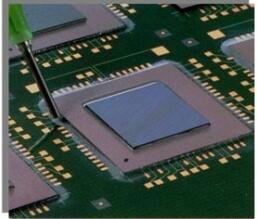Chip packaging refers to materials containing semiconductor devices. Encapsulation is an enclosure that wraps circuit materials to protect them from corrosion or physical damage and allows for the installation of electrical contacts connected to printed circuit boards.

The shell used for installing semiconductor integrated circuit chips plays a role in placing, fixing, sealing, protecting the chip, and enhancing its thermal performance. It also serves as a bridge between the internal world of the chip and the external circuits - the contacts on the chip are connected to the pins of the packaging shell through wires, which in turn establish connections with other devices through wires on the printed circuit board. Therefore, packaging plays an important role in both CPU and other LSI integrated circuits.
Common types of chip packaging
1. DIP dual inline
DIP (Dual Inline in Package) refers to an integrated circuit chip that is packaged in a dual inline format. The vast majority of small and medium-sized integrated circuits (ICs) use this packaging format, with a general number of pins not exceeding 100. CPU chips packaged with DIP have two rows of pins that need to be inserted into chip sockets with a DIP structure. Of course, it can also be directly inserted into circuit boards with the same number of solder holes and geometric arrangements for welding. Special care should be taken when inserting and unplugging DIP packaged chips from the chip socket to avoid damaging the pins.
Features:
1) Suitable for punching and welding on PCB (printed circuit board), easy to operate.
2) The ratio between packaging area and chip area is large, so the volume is also large.
The 8088 in the Intel series CPU adopts this packaging form, as well as cache and early memory chips.
2. Component encapsulated
The distance between chip pins in PQFP (Plastic Quad Flat Package) packaging is very small, and the pins are very thin. Generally, large-scale or ultra-large integrated circuits use this packaging form, with serval pins generally exceeding 100. The chips packaged in this form must be soldered together with the motherboard using SMD (Surface Mount Device Technology). Chips installed using SMD do not need to be punched on the motherboard, as there are generally designed solder joints for the corresponding pins on the surface of the motherboard. Align each pin of the chip with the corresponding solder joint to achieve welding with the motherboard. The chip soldered on using this method is difficult to disassemble without special tools.
The chips packaged in PFP (Plastic Flat Package) mode are the same as those packaged in PQFP mode. The only difference is that PQFP is generally square, while PFP can be either square or rectangular.
Features:
1) Suitable for SMD surface mount technology installation and wiring on PCB circuit boards.
2) Suitable for high-frequency use.
3) Easy to operate and high reliability.
4) The ratio between the chip area and the packaging area is relatively small.
The 80286, 80386, and some 486 motherboards in the Intel series CPUs use this packaging form.
3. PGA pin net format
The PGA (Pin Grid Array Package) chip packaging has multiple square array pins inside and outside the chip, with each square array pin arranged at a certain distance along the circumference of the chip. According to the number of pins, it can be enclosed in 2-5 circles. During installation, insert the chip into a dedicated PGA socket. To facilitate the installation and disassembly of CPUs, a CPU socket named ZIF has emerged starting from the 486 chip, specifically designed to meet the installation and disassembly requirements of PGA-packaged CPUs.
Features:
1) The insertion and removal operation is more convenient and has high reliability.
2) Can adapt to higher frequencies.
The Intel series CPU, the 80486 and Pentium, as well as the Pentium Pro, all use this packaging form.
4. BGA ball grid array type
BGA packaging technology can be further divided into five categories
1) PBGA (Plastic BGA) substrate: Generally a multi-layer board composed of 2-4 layers of organic materials. In the Intel series of CPUs, Pentium II, III, and IV processors all adopt this packaging form.
2) CBGA (Ceramic BGA) substrate: refers to a ceramic substrate, and the electrical connection between chips and substrates is usually installed using FlipChip (FC). In the Intel series of CPUs, Pentium I, II, and Pentium Pro processors have all adopted this packaging form.
3) FCBGA (FilpChipBGA) substrate: Hard multilayer substrate.
4) TBGA (TapeBGA) substrate: The substrate is a ribbon-soft 1-2 layer PCB circuit board.
5) CDPBGA (Carity Down PBGA) substrate: Refers to the chip area (also known as the cavity area) with a square depression in the packaging center.
Features:
1) Although the number of I/O pins has increased, the distance between pins is much greater than that of QFP packaging, which improves the yield.
2) Although the power consumption of BGA increases, the use of controllable collapse chip welding can improve the electric heating performance.
3) The signal transmission delay is small, and the adaptive frequency is greatly increased.
4) The assembly can be coplanar welded, greatly improving reliability.
Chip packaging can protect chips from external environmental influences. Chips are very fragile and susceptible to external environmental influences such as temperature, humidity, dust, and static electricity. If the chip is not packaged, it will be easily affected by these factors, leading to damage or failure of the chip. Therefore, chip packaging can provide the necessary protection to ensure the long-term stability and reliability of the chip. Chip packaging can also provide necessary electrical and mechanical connections. The chip needs to be connected to other electronic components to achieve the functionality of the circuit.